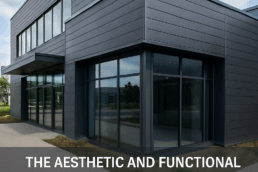Sheet metal fabrication plays a vital role in the creation of countless products we use every day. From the automotive and aerospace industries to consumer electronics and construction, sheet metal fabrication techniques are used to shape raw metal into functional components and structures. These techniques are essential for producing parts that meet precise specifications, ensuring both quality and performance.
The process of sheet metal fabrication involves a series of sophisticated methods that can handle a wide range of metals, including steel, aluminum, copper, and more. Each technique offers its own advantages and is suited to specific applications.
Hence, manufacturers need to choose the right method based on the project’s requirements. Understanding these techniques not only helps in selecting the appropriate method but also in optimizing the manufacturing process for efficiency and cost-effectiveness.
In this blog, we will explore ten common types of sheet metal fabrication techniques and provide insights into how they work and where they are most effectively applied. Whether you’re looking to create detailed designs, sturdy structures, or precise components, knowing these techniques will help you make informed decisions for your fabrication needs.
Techniques in Sheet Metal Fabrication
1. Cutting
Cutting is the first and most fundamental step in sheet metal fabrication. This process involves slicing large sheets of metal into smaller, more manageable pieces. There are several methods of cutting, each suitable for different types of metals and project requirements.
Shearing
Shearing is a precise cutting method used to cut straight lines in metal sheets. It involves using a machine, known as a shear, which has a pair of blades that move against each other to slice through the metal. Shearing is efficient and accurate. It’s ideal for producing clean edges with minimal waste. This technique is commonly used for cutting sheets into smaller sizes or for creating straight-edged parts.
2. Bending
Bending is a critical process in sheet metal fabrication, used to create angles and shapes in metal sheets. This technique is essential for forming parts that require specific angles and contours.
Press Brake Bending
Press brake bending involves using a press brake machine to bend metal sheets to specific angles. The press brake uses a punch and dies to apply force to the metal to create precise bends. This technique is highly versatile and can produce a wide range of shapes, from simple bends to complex geometries. Press brake bending is commonly used in the production of metal brackets, frames, and enclosures.
Roll Bending
Roll bending forms cylindrical shapes by passing metal sheets through a series of rollers. The rollers gradually bend the metal into a curved form, such as tubes or pipes. Roll bending is ideal for creating large-radius bends and circular components. This technique is widely used in the construction of tanks, pipes, and structural elements.
3. Assembling
Assembling involves joining multiple metal parts to create a final product. Various techniques are used in the assembling process. Each offers its own different advantages in terms of strength, flexibility, and efficiency.
Welding
Welding is one of the most common methods of assembling metal parts. It involves joining metal pieces by melting the edges and adding a filler material to form a strong bond upon cooling. There are several types of welding, including MIG (Metal Inert Gas), TIG (Tungsten Inert Gas), and stick welding. Welding provides strong, permanent joints for structural applications in construction, automotive, and industrial manufacturing.
Riveting
Riveting is a technique that connects metal parts using rivets, which are metal pins or bolts. The rivets are inserted through aligned holes in the parts to be joined and then deformed to hold the pieces together securely. Riveting is known for its strength and reliability. Also, it does not require heat. So, this makes it suitable for applications where welding is impractical. This technique is commonly used in the aerospace, automotive, and construction industries for creating strong, durable joints.
4. Punching
Punching involves creating holes in metal sheets using a punch press. This technique uses a punch and die set to punch through the metal, creating precise holes or shapes. Punching is highly efficient for producing parts with multiple holes or complex patterns. It’s commonly used in the manufacturing of metal parts for automotive, aerospace, and electronics industries.
CNC Punching
CNC (Computer Numerical Control) punching uses automated machinery to control the punch press for high precision and repeatability. This method is ideal for high-volume production runs where consistency is critical.
5. Stamping
Stamping is a process that involves pressing a sheet of metal between a die and a punch to create a specific shape or pattern. This technique is versatile and can produce a wide range of parts, from simple components to complex designs. Stamping is often used in the automotive industry to produce body panels, brackets, and other components.
Deep Drawing
Deep drawing is a type of stamping that forms metal sheets into deep, hollow shapes by pulling the metal into a die cavity. This technique is commonly used to create parts such as cans, containers, and automotive components.
6. Laser Cutting
Laser cutting uses a high-powered laser to cut precise shapes and patterns in metal sheets. This technique offers exceptional accuracy and can handle complex geometries and fine details. Laser cutting is widely used in industries that require high precision, such as aerospace, medical devices, and electronics.
7. Waterjet Cutting
Waterjet cutting uses a high-pressure stream of water mixed with abrasive particles to cut through metal sheets. This technique is suitable for cutting a variety of materials. This includes those that are sensitive to heat, as it does not generate heat during the cutting process. Waterjet cutting is commonly used in industries such as aerospace, automotive, and construction.
8. Extrusion
Extrusion is a process where metal is forced through a die to create long shapes with a fixed cross-section. This technique is often used to produce components such as pipes, tubes, and structural shapes. Extrusion is widely used in the construction, automotive, and electronics industries.
9. Hemming
Hemming involves folding the edge of a metal sheet back on itself to create a smooth, rounded edge. This technique is often used in the automotive industry to create strong, finished edges on body panels and other components. Hemming improves the structural integrity and appearance of the parts.
Hemming is widely used in the automotive industry, particularly in the production of vehicle body panels. The process ensures that the edges of the panels are smooth and free from sharp edges, which enhances both safety and aesthetic appeal. Hemming is also used in the manufacturing of household appliances to create finished edges on metal parts.
10. Embossing
Embossing is a process that creates raised or recessed designs on metal sheets by pressing them between patterned dies. This technique is often used for decorative purposes, as well as to add functionality, such as increasing the grip or stiffness of a part. Embossing is commonly used in the manufacturing of metal panels, nameplates, and packaging materials.
Understanding the different types of sheet metal fabrication techniques is essential for selecting the right method for your project. Each technique offers distinct advantages for specific applications. Whether you need precise cutting, intricate bending, or strong assembly, knowing the capabilities of each technique can help you achieve the desired outcome for your project.
At C&J Metal Products, we specialize in a wide range of sheet metal fabrication techniques. Contact us today to learn how our expertise can support your next project with precision, quality, and efficiency.



